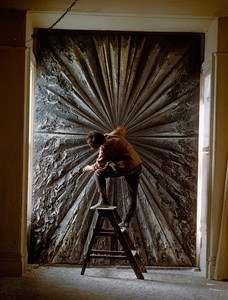
Jay DeFeo’s Transcendent Objects
Alice Godwin explores the shifts in Jay DeFeo’s practice in the 1970s, considering the familiar objects that became recurrent subjects in her work during these years and their relationship to the human body.
There is some experience of the element of risk in everything I do, making each work something of a cliffhanger. Somehow I’m not satisfied unless I’ve lived a little dangerously and survived.
—Jay DeFeo
Jay DeFeo (1929–1989) produced a diverse body of painting, drawing, collage, and photography that presents a highly individual vision of an artist’s physical environment, personal history, and metaphysical concerns.
Born in Hanover, New Hampshire, DeFeo grew up in the San Francisco Bay Area and studied at the University of California, Berkeley. After earning her master’s degree in 1951, she was awarded a fellowship and traveled in Europe and North Africa. Settling in Florence for six months, she produced her first major paintings, which reflect the influence of Abstract Expressionism and Italian architecture and borrow from the aesthetics of Asian, African, and prehistoric art. Returning to Northern California in 1953, DeFeo became a pivotal figure in San Francisco’s thriving Beat scene. Her images of this period are marked by a dynamic interplay of representational and abstract approaches. In 1959 her first major solo exhibition was held at the Dilexi Gallery in San Francisco, and her work was also featured in Sixteen Americans at the Museum of Modern Art in New York.
DeFeo’s masterpiece, The Rose (1958–66), a fusion of painting and sculpture eight years in the making, demonstrates the artist’s unswerving dedication to experimental forms. Quickly attaining renown, The Rose absorbed DeFeo’s attention so completely that she turned down several significant exhibition offers during the time it took to complete the work. First exhibited in 1969 at the Pasadena Art Museum, California, the massive impasto canvas was subsequently installed at the San Francisco Art Institute, where for many years it remained concealed behind a false wall, before being conserved and acquired by the Whitney Museum of American Art, New York, in 1995.
In 1966 DeFeo moved to Marin County, near San Francisco, and in the 1970s began to employ new methods and materials, including photography, in her art. Oil gave way to acrylic in her paintings, and canvas to Masonite or plywood panels. DeFeo often added textured media to the paint or applied collage elements such as paper, plastic, or objects to the surface. She described her works of this period, many of them marked by unexpected, often ambiguous interpretations of everyday objects, as “beings suspended in space and time” that “transcend the definition of the objects from which they are derived.” Often working in extended series, she established a complex internal network of formal and conceptual reference that spans multiple undertakings. In 1981 DeFeo moved to Oakland, California, and began to teach painting at Mills College. This coincided with a return to oil paint, in both large and smaller canvases, and works on paper, some of which revisit the imagery of her earliest works, and which retain a distinctive balance of precision and spontaneity.
DeFeo died on November 11, 1989, at the age of sixty. Since then, her work has been featured in museum and gallery exhibitions around the world. In 2012 the Whitney Museum organized Jay DeFeo: A Retrospective, which traveled to the San Francisco Museum of Modern Art. In addition to establishing the Jay DeFeo Foundation, the artist’s will endowed the Jay DeFeo MFA Prize at Mills College.


Alice Godwin explores the shifts in Jay DeFeo’s practice in the 1970s, considering the familiar objects that became recurrent subjects in her work during these years and their relationship to the human body.

Suzanne Hudson speaks with Leah Levy, executive director of the Jay DeFeo Foundation, about the artist’s life and work.